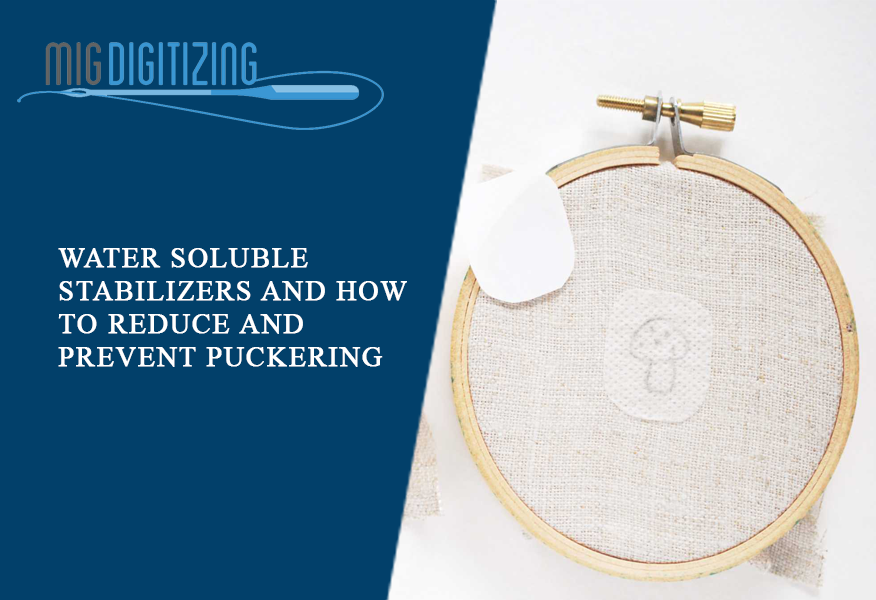
Puckering keeps the texture from laying level giving it an uneven appearance. Puckering looks horrendous, is amateurish and is something you ought to endeavour to kill in your embroidery projects. Embroidery puckering alludes to the get-together or grouping of texture close to weaving join and occurs from the texture moving around during weaving. Each new weave encounters puckering of their plans sooner or later. There are a few factors that by themselves or consolidated can cause puckering.
Poor Digitizing
Ineffectively digitized plans and plans utilizing an auto-digitizer can here and there line our own inadequately in spite of whatever else you do. An expert digitizer will make a plan in a manner that can consider the texture you are embroidery on and digitize to lessen puckering. Embroidery digitizing is an expertise in itself separate from the ability to dominate embroidery.
Under-Stabilized Fabric
Cutaway support is generally more steady and ought to be utilized with sews and other stretchy articles of clothing. The more stretchy your texture and the bigger and more thick your embroidery plan - the more adjustment required. The most widely recognized justification for puckering is an insufficient adjustment, typically insufficient or not the right sort of stabilizers.
String Tensions To Tight
On lighter weight and sensitive textures, in some cases utilizing rayon string, because of its decreased stretchiness and lower required strains, will create a superior looking without pucker plan. Excessively close string and bobbin pressure can make a lot of pull on the fastens causing bending and puckering.
Not Hooping Correctly
You need to make an instructed tambourine like surface without extending your piece of clothing. To accomplish the best adjustment of your texture, you should band your piece of clothing with the littlest loop the plan will fit in and ensure you are hooping your piece of clothing effectively. At the point when this is done your embroidery will look fine while still hooped yet when eliminated from the band all the texture that isn't bolted under the join will unwind and cause puckering. On the off chance that you stretch your texture when you loop, you will freeze the texture in a loosened up state under the lines.
Tips To Prevent Puckering
Set Correct Thread Tensions
When making pressure changes, just make slight changes all at once. Use string pressure measures to accurately set your machine string strains dependent on the sort of string you are utilizing.
Pick The Correct Stabilizer
Shrouded above and in other blog entries; ensure you are coordinating with your stabilizer type and weight to the current task.
Digitize Correctly
While digitizing, the right utilization of an underlay can help settle the texture. On the off chance that you don't have digitizing experience, employ a respectable digitizer and let them know the kind of texture you will weave on.
Use Spray Adhesive
The light utilization of brief texture cement, particularly with elusive and stretchy textures, can give the additional adjustment you need to keep the texture from moving and moving during embroidery.
Lessen Density
For lighter weight and stretchy textures, lower thickness plans generally join best. Pick open plans without enormous inclusion and completely filled in zones.
Loop Garments
Continuously accurately loop your articles of clothing utilizing the littlest circle conceivable. The nearer the sides of your band are to your plan, the more adjustment your circle will give.
What are Water Soluble Stabilizers?
Water-solvent support is accessible in a weighty plastic-like film type and a stabilizer that looks like texture. The two of them do exactly the same thing and which one you use is an individual inclination. Water-solvent stabilizers are embroidery support that breaks down 100% in water and vanish. It's doesn't require some investment in the weaving interest until you experience the term Water Soluble Embroidery Stabilizer, curtailed as WSS.
Most WSS will break down whenever submerged and fomented in tepid water. Ensure all the support breaks up and the buildup is washed off your fastens before it dries once more. At the point when you are prepared to disintegrate the stabilizer, it's normally best to remove however much you can first to limit any wreck.
What's a tear-away/wash away stabilizer, is that exactly the same thing? After washing a tear/wash away, the fastener disintegrates permitting the sponsorship to fall to pieces and the strands to wash away, yet the join remains immovably bolted because of the filaments that stay under the lines. A tear-wash away embroidery stabilizer is produced using non-solvent strands (that don't break down in water) held together by a water-dissolvable fastener. A WSS is produced using water-solvent filaments that disintegrate in water.
You can utilize water-solvent sponsorships free of charge movement or customized automated embroidery digitizing. For nothing movement work, they're incredible when you're working with textures that might be hard to stamp, you can draw your plan directly on them to make your own sewing guide design.
With unattached ribbon, you can make nitty-gritty pieces like trimmings, adornments, gems, and that's just the beginning. The plans are autonomous or "unsupported" and hold themselves together once the stabilizer is broken down. Unattached ribbon, or FSL, is the thing that water solvent stabilizers are generally utilized for. FSL plans are digitized to remain together without the help of a stabilizer.



